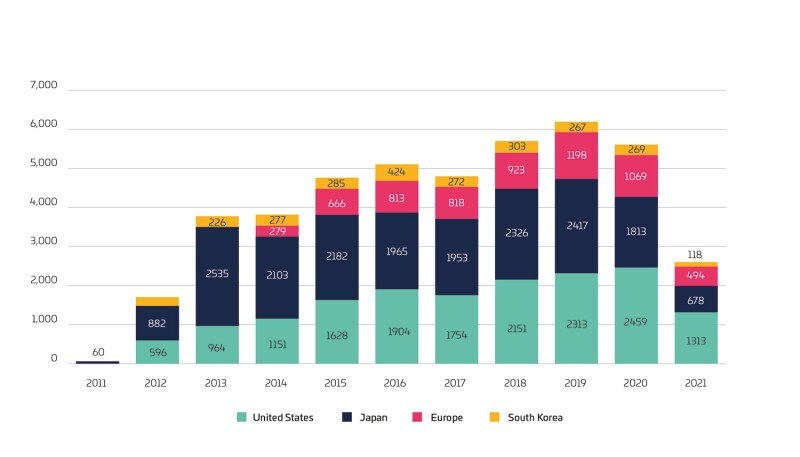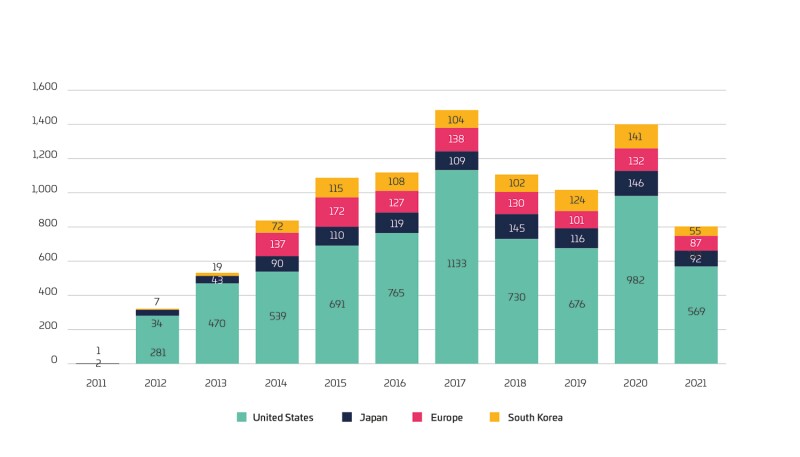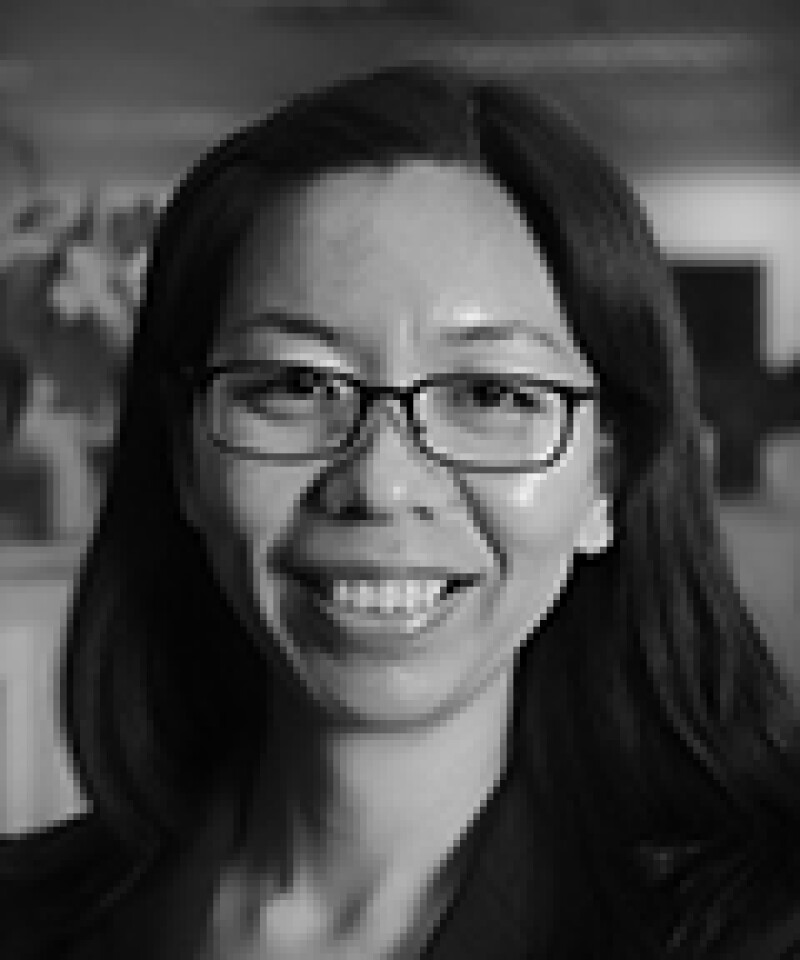Patent Prosecution Highways (PPH) is a programme that provides a fast examination channel for foreign applicants. Since the PPH pilot was started between the JPO and the USPTO in 2006, the number of IP offices participating in the PPH programme via the bilateral or multilateral agreements has gradually increased, and now 55 offices have participated in the PPH programme.
The PPH programme is proposed with the economic globalisation and the enhancement of the enterprises’ awareness of IP protection. The patent application of the enterprises is no longer limited within the own countries.
With the increase of the foreign patent applications, the examination burden of IP offices in various countries/regions increases year by year. For the patent application of the same invention entering a plurality of countries, the examiners in various countries may repeatedly search and examine.
To reduce the examination burden, improve the examination quality, shorten the examiner cycle, reduce the examination cost and improve the grant rate, the PPH programme has emerged.
At present, the PPH programme is a patent examination cooperation programme with high participation and utilisation rate around the world, and is an effective means for foreign applicants to obtain an early examination of application entering China.
The basic concept
PPH means that, in the case that at least one or more claims contained in the application submitted by the applicant in the office of first filing (OFF) are determined to be grantable, the applicant can submit a request for accelerated examination of the subsequent application to the office of second filing (OSF).
The above basic concept was first proposed when the PPH bilateral agreement on patent applications was signed between the US Patent and Trademark Office and the Japan Patent Office in July 2006. However, in the actual patent applications to foreign countries, the IP office, which first made the examination results of grant, is not the OFF due to the differences in patent examination systems and examination cycles in various countries.
In July 2011, the JPO proposed the PPH expansion pilot programme- PPH MOTTAINAI, which expands the acceptance conditions of PPH, that is, adding the situations that the OFF is the IP office of the third country/region and that the OSF makes the examination result of grant in advance.
Thus, the concepts of the Office of Earlier Examination (OEE) and the Office of Later Examination (OLE) emerge. At present, the concepts of the OEE and the OLE are widely employed in PPH practice in China. Therefore, it can be considered that the PPH means that, in the case that at least one or more claims contained in the application submitted by the applicant in the OFF are determined to be grantable by the OEE, the applicant can submit a request for accelerated examination of the subsequent application to the OLE.
Classification of PPH
There are five types of PPH: Normal PPH, PPH MOTTAINAI, PCT-PPH, IP5 PPH and Global PPH.
Normal PPH means that the applicant makes a PPH request to the OSF using the domestic work products made by the OFF, and can be further divided into PPH via the Paris Convention and PPH via PCT. the difference between the PPH via PCT and the PCT-PPH lies in that the PPH via PCT depends on the work products made in the national state, whereas the PCT-PPH depends on the work products made in the international stage.
PPH MOTTAINAI is an expanded procedure based on Normal PPH, can make use of the PPH procedure without being restricted by the fact that the OFF first makes the work products, and thus increases the opportunity for the applicant to make use of the PPH procedure.
|
|
“To reduce the examination burden, improve the examination quality, shorten the examiner cycle, reduce the examination cost and improve the grant rate, the PPH programme has emerged.” |
|
|
It should be noted that, although based on Normal PPH, PPH MOTTAINAI cannot be used as long as Normal PPH is included, and can be used only in the countries/regions participating in PPH MOTTAINAI.
PCT-PPH is a procedure which uses the work products in the international phase for PCT application. These work products in the international phase include: the Written Opinion of the International Searching Authority (WO/ISA), the Written Opinions of the International Preliminary Examining Authority (WO/IPER), International Preliminary Examination Report (IPER).
Both the PCH-PPH and the PPH via PCT of Normal PPH are PPH related to PCT application, the PPH via PCT needs to wait for the examination products of national stage, but the PCT-PPH uses the work products of international state and thus facilitates early examination and the grant.
IP5 PPH is an examination cooperation procedure implemented on January 6, 2014 between five offices (IP5) including CNIPA, JPO, EPO, KIPO and USPTO, and meanwhile Normal PPH, PPH MOTTAINAI and PCT-PPH can also be implemented between IP5.
Global PPH is established to solve the problem of inconvenience to the applicant due to the different requirements of PPH request by the OLE. According to the programme, a unified qualification applicable standard is employed, when one of the participating offices makes an examination result of grant, the applicant then may request other participating offices to accelerate the examination. Like IP5 PPH, Global PPH was implemented on January 6, 2014, and Normal PPH, PPH MOTTAINAI and PCT-PPH can also be implemented.
At present, 27 countries/regions have joined the Global PPH programme, China has not joined this programme and thus Normal PPH, PPH MOTTAINAI, PCT-PPH and IP5 PPH can be implemented in China.
Practice of PPH in China
It has been 10 years since China implemented the first PPH programme with the JPO on November 1, 2011. During these 10 years, China has signed bilateral/multilateral PPH agreements with 30 foreign patent examination institutions, such as US, Germany, South Korean, Russia and the Eurasian patent office. Among them, the utilisation of PPH is highest between China and US, Japan, Europe and South Korea.
The charts show the PPH application numbers in other four offices when China is the OLE and the OEE (the PPH application numbers in 2021 in this figure refer to those from January to June 2021).
Chart 1: Officer of later examination (OLE)

Chart 2: Officer of earlier examination (OEE)

As can be seen from the charts the numbers of PPH request submitted by US and Japan to the CNIPA far exceed those in other countries or regions. The China’s PPH requests abroad are mainly directed to US, which substantially corresponds to the numbers of overseas application submitted by the applicants from various countries.
Further, from January to June 2021, in China, the average time from the filing of the PPH request to the receipt of the first office action is 2.2 months, and the average time from filing the PPH request to the receipt of the final examination results is 11 months, and the average number of office actions received in the substantial examination as for the application filing PPH request is 1.
The PPH request to China can greatly speed up the examination time, fully make use of the examination results of the OEE, enable the patent applications to be granted as soon as possible and improve the grant rate.
(Note: the data herein refers to the information disclosed from PPH global portal https://www.jpo.go.jp/toppage/pph-portal-j/index.html).
Key points when submitting a PPH request
(1) When submitting a PPH request, the claims in China and the claims of the corresponding application that has been found allowable/patentable by the OEE should meet the sufficient correspondence which means the protection scopes of the claims are exactly same or smaller. It should be noted that ‘smaller protection scope’ can be understood to further define the claims based on the original records in the Chinese description and not to further define the claims by summarising the technical features even if the summarised technical feature does not go beyond the scope disclosed in the original description and claims.
(2) Chinese patent application must have been published. That is, the PPH request in China must be submitted until the notice of publication of the patent application is made by the CNIPA.
(3) Chinese patent application must have entered the stage of substantive examination. That is, the PPH request in China must be submitted until the notice of entering the substantive examination stage is made by the CNIPA.
However, an allowable exception is that the applicant may make a PPH request at the same time of filing a request for substantive examination.
(4) Chinese patent application has not received any notice of office action made by the substantive examination department of the CNIPA.
(5) Chinese patent application must be an electronic application.
(6) There are only two opportunities to make a PPH request and the requirements for submitting PPH should be strictly observed.
(7) When making a Normal PPH request, the granted announcement text of the corresponding application should be published. When making a PCT-PPH request, the PCT application should be published. Although it is not the reasons why the PPH request is not passed that the granted announcement text and the PCT application has not been published, the CNIPA will examine whether such PPH request meets the conditions of the PPH request, that is, to review whether the PPH request meets the related conditions after the publication of the granted announcement text and the PCT application.
(8) The opinion on the possibility of grant/patentability made by the OEE must be the latest examination results. When the third party raises an invalidation or objection to the corresponding application after the OEE has made a decision to grant the corresponding application and the announcement text has been issued, it is necessary to wait until the results of the invalidation or objection is made before considering whether or not to submit the PPH request.
PPH programme plays a positive role
As a programme sharing the patent examination results among various participating countries, PPH programme brings about the benefits of accelerating examination, saving costs, having a higher grant rate, reducing the examination workload, improving the quality of examination, and is currently the most extensive and active international cooperation programme in patent examination around the world.
It plays a positive role in terms of promoting patent examination cooperation among countries, boosting technology innovation and protecting IP rights.
Click here to read all the chapters from Managing IP's China IP Special Focus 2022

Shengjie Piao
Patent attorney
DEQI Intellectual Property
T: +86 10 8233 9088
Shengjie Piao is the patent attorney of DEQI Intellectual Property in Beijing.
Shengjie focuses on IP legal services, and has abundant experience in patent prosecution, patent reexamination and invalidation in the fields of chemical, materials, biology and medicine. In addition, she also has experience in analysis and advice regarding patent protection, including evaluation of patentability and infringement evaluation.
Shengjie obtained a master’s degree in applied chemistry from Beijing University of Chemical Technology and has 17 years of experience in IP profession. She is a member of the All-China Patent Agents Association.











